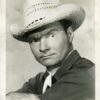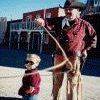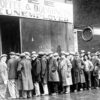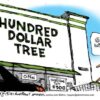The Plot to Out Ronald Reagan
![]()
The Plot to Out Ronald Reagan
A group of Republicans tried to stymie what they alleged was a nefarious homosexual network within the campaign of their own party’s standard-bearer. More than 40 years later, the story can finally be told.

Illustration by Derek Abella
By JAMES KIRCHICK
05/27/2022 04:30 AM EDT
James Kirchick is the author of the forthcoming book Secret City: The Hidden History of Gay Washington, from which this article is adapted.
With his new book, James Kirchick offers a window into an era when “the fear of homosexuality, or even the mere accusation of it, destroyed careers, ended lives, and induced otherwise decent people to betray colleagues and friends.” In this exclusive excerpt, he reveals the extent to which whisperings of a conspiracy from California to Washington, when met with political opportunism and overblown anxiety over the potential presence of gay people in positions of power, nearly altered the course of history.
It was 3:15 on the morning of June 26, 1980, and Congressman Bob Livingston was extraordinarily drunk, hiding in the congressional gym beneath the Rayburn House Office Building, petrified that a team of highly trained right-wing homosexual assassins working on behalf of Ronald Reagan was about to kill him.
To the extent that the Louisiana Republican is remembered today, it’s for the brief but sensational role he played in America’s most infamous political sex scandal. On the same day in December 1998 that Bill Clinton was impeached for lying about his affair with a White House intern, Livingston, then the House speaker-designate, shocked the nation with his own admission of adultery. Preempting a journalistic exposé that had dredged up evidence of his past relationships with women not his wife, he not only refused the speakership but announced his resignation from Congress altogether.

What people don’t know is that nearly two decades before this bit part in the Clinton impeachment drama riveted the nation, Livingston was at the center of another scandal involving politicians and illicit sex, one that, in his own words, had the potential to be “world-shaking.” Most explosive about this whole terrible intrigue, and what tied it all together, was the nature of the sexual activity involved.
For most of the 20th century, the worst thing one could possibly be in American politics was gay. The mere insinuation of homosexuality was sufficient to destroy a political career, and things could get particularly vicious between intraparty adversaries. The first outing in American politics, of the isolationist Massachusetts Sen. David Walsh in 1942, was perpetrated by interventionist allies of fellow Democrat, President Franklin D. Roosevelt. While public attitudes have become far more open, the insinuation that someone is gay — whether true or not — remains a potent weapon (as elements of the campaign against North Carolina Republican Rep. Madison Cawthorn recently illustrated), especially in socially conservative milieus.
This account of the alleged “homosexual ring” that controlled Ronald Reagan, and the efforts to expose it on the eve of the 1980 Republican National Convention that nominated him for the presidency, is compiled from interviews with several of the surviving participants and documents uncovered in the papers of former Washington Post Executive Editor Ben Bradlee. Appropriately for a story involving what was once considered the gravest sin in American politics, it has never been told until now.

The series of events that led Livingston to take refuge in the warrens of a Capitol Hill basement began innocently enough.
Shortly before closing his office on the evening of June 25, Livingston’s secretary received a phone call from L. Francis Bouchey, executive vice president of a small conservative foreign policy think tank called the Council for Inter-American Security. Bouchey’s wife was out of town, and he was home alone facing the unsavory prospect of a TV dinner. Was Livingston free for supper? As luck would have it, Livingston’s secretary said, the congressman’s wife was also away, and his evening was open. Bouchey and Livingston would meet at 7:30 at The Palm near Dupont Circle.
Bouchey drove into the city from his home in Annandale, the pleasant suburban community where Livingston also happened to live with his family. The men had several other things in common. Both were 37 years old, brothers of the Delta Kappa Epsilon fraternity and committed conservatives. One of Bouchey’s responsibilities was to enlist up-and-coming legislators in the cause of rolling back communism across Latin America, a crusade that was beginning to assume great significance at the dawn of the 1980s. As the congressman representing the Port of New Orleans, Livingston had every reason to worry about this threat, and when Bouchey offered him a seat on the council’s advisory board, he was happy to accept.

Want to read more stories like this? POLITICO Weekend delivers gripping reads, smart analysis and a bit of high-minded fun every Friday. Sign up for the newsletter.
But over dinner, three weeks before he and his fellow Republicans were to gather at the Joe Louis Arena in Detroit for their national convention, Livingston had something more urgent on his mind than the twilight struggle between capitalism and communism. For months, speculation had been mounting as to whom Reagan would choose as his running mate. The former governor of California needed a veep candidate who could heal the widening divide within the GOP between its moderate establishment and conservatives like himself. Some of the top contenders were former CIA Director George H. W. Bush, who had recently bowed out of the race for president, and former President Gerald Ford. But it was the serious consideration of a fellow House colleague — Rep. Jack Kemp — that most piqued Livingston’s interest. Bouchey’s group was informally advising the Reagan campaign on Latin American issues. Perhaps Bouchey had a window into its deliberations.
MOST READ

- Dr. Oz jumps the gun, declares himself ‘presumptive’ GOP Senate nominee
- Prosecution: ‘Overwhelming’ evidence of guilt for Clinton campaign attorney
- Two Professors Found What Creates a Mass Shooter. Will Politicians Pay Attention?
- Centrist Schrader ousted in Oregon primary
- Judge dismisses Trump’s lawsuit seeking to stop New York civil probe
“Do you know anything about Kemp, is he AC/DC?” Livingston asked, referencing not the Australian hard rock band but the slang expression for bisexual.
“Yeah, I heard some things,” Bouchey replied. “That stuff’s been around.”
“That stuff,” or what Kemp adviser Jude Wanniski termed “the homosexual thing,” had dogged the upstate New York congressman and former professional football player since the fall of 1967, when the syndicated newspaper columnists Drew Pearson and Jack Anderson published a piece linking Kemp to a “homosexual ring” operating within Reagan’s gubernatorial office. Kemp, then the starting quarterback for the Buffalo Bills and an aspiring policy wonk, had spent the summer offseason working for Reagan as perhaps the most famous intern in America. According to the muckraking duo, Reagan’s security chief had obtained “a tape recording of a sex orgy” held at a Lake Tahoe cabin leased by two Reagan staffers, and while Pearson and Anderson didn’t name any names, in the case of Kemp, they didn’t have to. One of the eight men involved, they wrote, was an “athletic adviser on youth activities who has since gone on leave for the fall athletic season.”


































![Lieutenant-Colonel Robert Rogers (7 November 1731 – 18 May 1795) was a British Army officer and frontiersman. Born in Methuen, Massachusetts, he fought in King George’s War, the French and Indian War and the American Revolutionary War. During the French and Indian War, Rogers raised and commanded Rogers’ Rangers, a ranger unit trained for carrying out asymmetric warfare.[2][3](https://www.cowboyron.com/wp-content/uploads/2022/05/1262463_580743685323360_2133853937_o1-1-150x150.jpg)
















![Billie Joe Armstrong & Norah Jones – Silver Haired Daddy Of Mine [Music Video]](https://www.cowboyron.com/wp-content/uploads/2022/11/Al_St._John1-100x100.jpg)

























